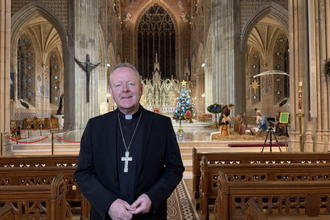Angelica Kauffman celebrated at Royal Academy

Christ and the Samaritan Woman, by Angelica Kauffman. 1796. On loan from Bayerische Staatsgemäldesammlungen Munich - Neue Pinakothek.
Angelica Kauffman was a neo classicist painter likened to a female Raphael and considered 'possibly the most cultivated woman in Europe.' Her popularity was known as 'Angelica mad'.
Born in Switzerland in 1741 to a Swiss mother and Austrian father, an established artist who trained his daughter.
Considered a child prodigy, both as a talented soprano - the original 'voice of an angel' and as an artist. She painted European royalty and undertook a commission from Pope Pius VI for an altar piece for the Swiss Chapel for the basilica of the Holy House of Loreto.
She was noted for her history paintings, a popular genre, but injected her own style by projecting female roles rather than masculine heroes in her compositions such as Eleanor of Castille, Margaret of Anjou and Lady Jane Grey. Her classical mythological paintings similarly focus on heroines such as Penelope, Ulysses wife.
She travelled Italy gaining fame and was encouraged by Lady Wentworth, wife of the British Ambassador in Venice to come to England in 1766. Her portraits were in great demand and can be seen in aristocratic houses from Devon to London to this day. Her striking portrait of actor David Garrick depicting him seated, twisting to look quizzically at the viewer heralded her English residency.
She moved in society and became friends with Queen Charlotte, painting her with her son, the future George IV as the Genius of Fine Arts of which an engraving is displayed, the original being lost.
As one of two women co-founders of the Royal Academy this exhibition is long overdue.Starting with a middle-aged self-portrait in Traditional Costume of the Bregenz Forest, she projects astuteness and charm. She married the painter Antonio Zuccio the same year in 1781. (Previously her 1767 marriage to a bogus count and conman, was annulled.)
Her religious paintings were considered of such note that her two later masterpieces The Samaritan Woman at the Well, displayed in the last exhibition room, and Nathan and David were carried in her funeral procession behind her coffin. The Samaritan Woman is portrayed seated alongside Christ on the edge of the well in close discourse. Most depictions show one figure seated and the other standing, separating Christ the Jew and the Samaritan woman, whose race were considered heretics. Samaritans considered Mount Gerazim, situated in the West Bank, where Noah's Ark landed and site of Abraham and Isaac's sacrifice, to be where the Messiah would reveal himself. The Temple Mount in Jerusalem was the site for Jews where this revelation would occur. Between the figures a mountain is seen rising prominently in the background, emphasising this ethos.
Jesus reveals himself as Messiah to her, pointing to himself and his heart with one hand and the other pointing heavenwards in a form of benediction. At that time a Jewish man would not talk with a woman so familiarly, let alone a Samaritan with "a past". Jesus breaks down the barriers and points to himself as the unifying Messiah who invites the woman to give him water to drink but gives her the water of life through his words. She becomes a messenger, proclaiming him as Messiah to her community who come to belief in him as a result. In Western tradition she is nameless, but in Eastern Orthodoxy she is known as Photini, "enlightened one".
Kauffman captures the scene with great depth of perception. The colours in her dress and headband, and Christs' robe and cloak, mirror each other as do their positioning. There is an equality and equanimity between them.
She became close friends with Joshua Reynolds and both painted each other. He called her 'Miss Angel.' When the Royal Academy displayed a satirical painting that alluded to her in a scurrilous manner dressed in nothing but black stockings, she insisted it be removed or she would withdraw all her paintings.
In 1780 the Royal Academy commissioned her to paint The Elements of Art for the entrance hall. These four evocative oval ceiling pictures depict Invention, Design, Composition and Colouring,
In London, Kauffman's allegorical works were frequently reproduced in stipple engravings. She produced her largest work in this medium with life sized figures "Religion attended by the Virtues",1799-1801. It was one of the first works to enter the National Collection but believed lost during Nazi air raids. All that remains are engravings of it.
One of the most captivating pictures is her acclaimed Self Portrait at the Crossroads Between the Arts of Music and Painting,1794 mirroring her choice between the two arts.
Returning to Rome after fifteen years she opened a studio near the Spanish Steps and produced more religious works including several altarpieces.
The delightful exhibition concludes with a letter to the Royal Academy recounting her death on 5th November 1807 and funeral in Rome organised by the St Luke Academy and the sculptor Canova. She was buried beside her husband in the Basilica of St.Andrea delle Fratte.
A bust of her was subsequently placed beside that of Raphael in the Pantheon, so highly was she regarded.
The exhibition runs until 30th June 2024. Admission £17. Catalogue £20.
LINK
Angelica Kauffman celebrated at Royal Academy - www.royalacademy.org.uk/exhibition/angelica-kauffman


















